
Fuchsia is a genus of flowering plants that consists mostly of shrubs or small trees.

Fuchsia excorticata, commonly known as tree fuchsia, New Zealand fuchsia and by its Māori name kōtukutuku, is a New Zealand native tree belonging to the family Onagraceae. It is commonly found throughout New Zealand and as far south as the Auckland Islands. It grows from sea level up to about 1,000 m (3,300 ft), particularly alongside creeks and rivers. It is easily recognised in its native environment by the characteristic appearance of its bark, which peels spontaneously, hanging in red papery strips to show a pale bark underneath. Its scientific name, excorticata, reflects this distinctive property.
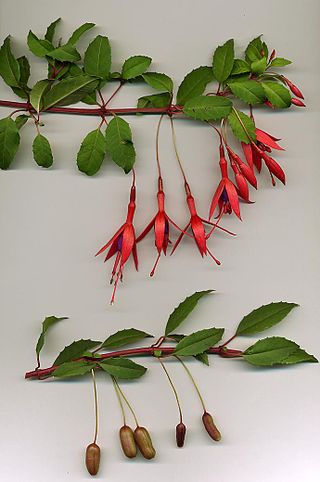
Fuchsia magellanica – commonly known as the hummingbird fuchsia, hardy fuchsia or chilco – is a species of flowering plant in the evening primrose family Onagraceae, native to the lower Southern Cone of southern South America.

Eremophila latrobei, commonly known as crimson turkey bush, native fuchsia, Latrobe's emu bush, grey fuchsia bush, warty fuchsia bush and Georgina poison bush is a flowering plant in the figwort family, Scrophulariaceae and is endemic to Australia. It is an erect, highly branched shrub with usually linear leaves and red to purple-red flowers and which occurs in all mainland states, including the Northern Territory but excluding Victoria.

Fuchsia loxensis is a species of fuchsia in the family Onagraceae. It is endemic to Ecuador.
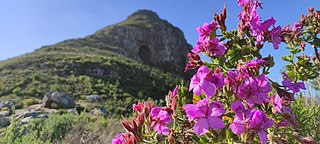
Pelargonium cucullatum is a hairy, upright, branching, perennial shrub, of 1–2 m (3.3–6.6 ft) high, that has been assigned to the cranesbill family. It sprouts new stems from the underground rootstock and becomes woody at its base. It has alternately set, sometimes slightly succulent leaves crowded near the top of the branches, with leaf stalks and flat to hood-shaped leaf blades, with a rounded broad triangular to kidney-shaped outline of about 4–5.5 cm long and 5–9 cm wide, often somewhat incised, the margin with irregular teeth. The white to purplish red, 5-merous, somewhat mirror symmetrical flowers grow in umbel-like clusters, and each contain mostly 7 fertile stamens and 3 infertile staminodes of different length. P. cucullatum has been cultivated as a garden ornamental and house plant since the 17th century. It has been used to breed many modern pelargonium hybrids, notably the Regal pelargoniums. It is called hooded-leaf pelargonium or herba althaea in English and wildemalva in Afrikaans.
Drosera peruensis is a carnivorous plant of the genus Drosera, commonly known as the Peruvian sundew. This Drosera species was first identified in Peru in 2002 by Tânia Regina dos Santos Silva and Mireya D. Correa following work to update the genus Drosera for the reference text, Flora Neotropica..

Persoonia asperula, commonly known as mountain geebung, is a plant in the family Proteaceae and is endemic to south-eastern Australia. It is an erect or prostrate shrub with smooth bark, mostly elliptic to oblong leaves and yellow flowers borne singly or in groups of up to nine. It mostly occurs in the Southern Highlands of New South Wales. A small population in Victoria may be a different species.
Eremophila prostrata, commonly known as Rainbow Valley fuchsia bush, is a flowering plant in the figwort family, Scrophulariaceae and is endemic to the Northern Territory. It is a prostrate shrub with glabrous branches and leaves and purple flowers. It occurs as a few scattered populations with a total area of less than 50 ha.
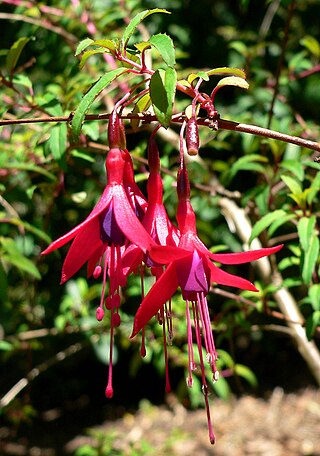
Fuchsia campos-portoi is a plant of the genus Fuchsia native to Brazil.
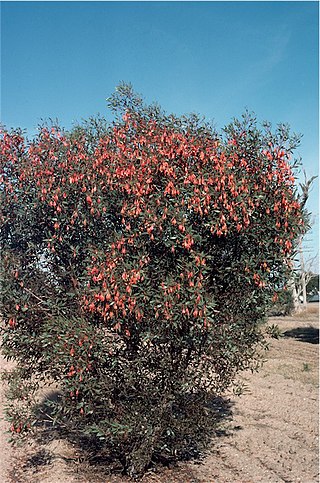
Eucalyptus dolichorhyncha, commonly known as the fuchsia gum, is a species of mallet that is endemic to the south-west of Western Australia. It has smooth, pale grey over pale brown bark, lance-shaped to oblong adult leaves, pendulous, solitary, red flower buds in leaf axils, yellow flowers and winged fruit that is square in cross-section.
Calytrix breviseta is a species of flowering plant in the myrtle family Myrtaceae and is endemic to the south-west of Western Australia. It is a more or less glabrous shrub with egg-shaped, elliptic, lanceolate, oblong or linear leaves and clusters of purple flowers with about 25 to 65 white stamens in several rows, becoming reddish-purple as they age.

Fuchsia simplicicaulis is a species of shrub in the family Onagraceae. It is endemic to Peru. Its Herbaria type is electrotype MA 11/92 11.

Passiflora bogotensis is a climbing plant native to Colombia, in the genus Passiflora. It can also be found in Venezuela.

Fuchsia glazioviana, called Glaziou's fuchsia, is a species of flowering plant in the genus Fuchsia, native to southeast Brazil. It has gained the Royal Horticultural Society's Award of Garden Merit.

Fuchsia hatschbachii, called Hatschbach's fuchsia, is a species of flowering plant in the genus Fuchsia, endemic to the state of Paraná in Brazil. It has gained the Royal Horticultural Society's Award of Garden Merit. The species is named after Gert Hatschbach, Director of the Museu Botânico de Curitiba who collects and studies flora of Paraná.

Hovea asperifolia is a species of flowering plant in the family Fabaceae and is endemic to south-eastern continental Australia. It is a shrub with hairy branchlets, narrowly oblong to narrowly linear leaves with stipules at the base, and mauve, pea-like flowers.
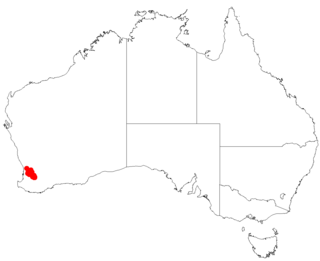
Leucopogon darlingensis is a species of flowering plant in the heath family Ericaceae and is endemic to the south-west of Western Australia. It is an erect shrub with hairy young branchlets, spirally arranged, linear, oblong, narrowly elliptic or narrowly egg-shaped leaves and white, bell-shaped flowers arranged in upper leaf axils and at the ends of branches.
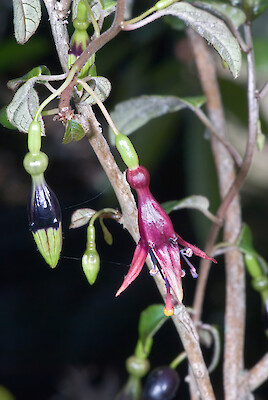
Fuchsia perscandens, commonly known as climbing fuchsia or scrambling fuchsia, is a species of plant endemic to New Zealand and belonging to the family Onagraceae. Fuchsia perscandens belongs to the South Pacific Skinnera section, which consists of three species and a hybrid.

Fuchsia bracelinae is a species of Fuchsia found in Brazil.

















